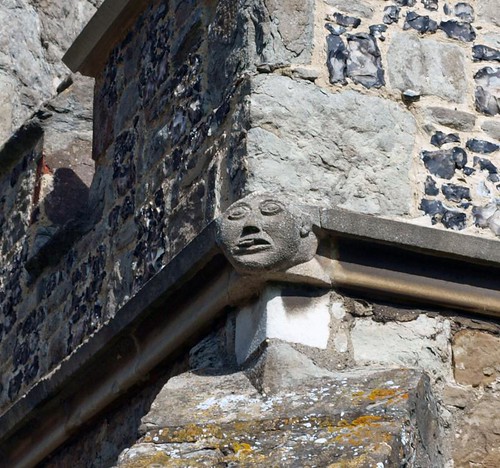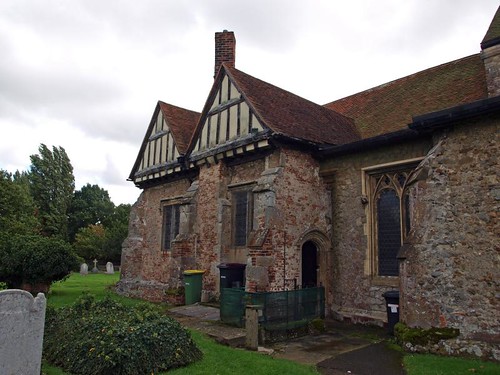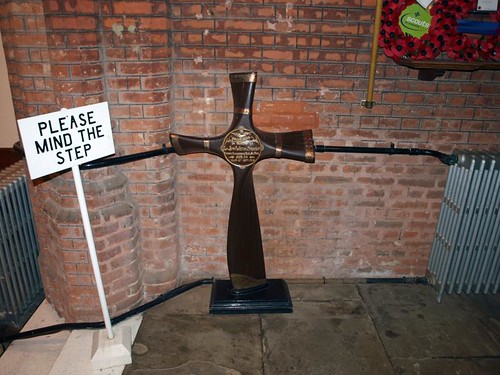All the interest here is external - except the tower arch; a very unEssex south porch, a Tudor tower (reminiscent of Rayne) and a strange, I assumed, Tudor double gabled NE chapel; Essex bling at it's best.
The town is quite separate from the church and the great house, and the separation became specially obvious when the railway arrived and cut off the town completely.
ST ANDREW. The piéce de résistance is the big tall W tower of brick, with diapers of vitrified headers, angle buttresses, a higher SE stair turret, a big three-light Perp brick window, and battlements. The N side of the church has behind the tower Victorian N aisle and clerestory windows, and then the chancel chapel also of red brick, but with two surprising and charming half-timbered gables. The S side was the show side. It has on the aisle and the porch battlements faced with stone and flint chequer-work. The E view is dominated by the five-light chancel and the three-light S aisle and N chapel windows. The interior has three-bay arcades on octagonal piers with double-chamfered arches. The tower arch is uncommonly tall. The whole is of the late C15 to early C16. - PLATE. Cup and Paten of 1705. - BRASS to Mary Dilcok d. 1514; small figure.
ROCHFORD. A stately avenue of oak and elm leads us to this small town on the River Roche, and a quiet market square comes as a surprise round the corner. There are many quaint houses with gables and overhanging storeys. In Church Street is a steep roofed building as charming as when Robert Rich, first Earl of Warwick, built it for poor old folk in the days of Shakespeare.
Rochford Hall, his home, is not far away. Its ancient grandeur has departed, but a turret remains where two gable-windowed roofs meet. Four hundred years ago it had three or four courtyards in which would walk a girl Sir Philip Sidney loved, Penelope Devereux, whose charm he made immortal in his sonnets, where she is Stella and he is Astrophel. Alas, Penelope married Robert Rich, one of the first noblemen to follow the Puritan way of life in an age of gaiety, but deserted him for the frivolous Earl of Mountjoy. Her eldest son was one of the romantic figures of the Civil War.
Rochford Hall is on the site of one of the homes of Sir Thomas Boleyn, father of Anne Boleyn, friend of Wolsey, and friend of the king who was to hound him to his doom.
In the middle of a field is the church which owes much of its stately grandeur to the hall. The tower, a magnificent example of the early brickwork of the Tudor Age, was built in 1500, when an heiress married the grandfather of Anne Boleyn, bringing the hall as her dower. Most of the church was made new in the 15th century, but in the east wall of an aisle is the beautiful net tracery used for windows 600 years ago. A brass portrait of the infant Christ has vanished from the nave, but there is a brass of Mary Dilcock of 1518.
Robert Rich, the second Earl of Warwick, was born under Queen Elizabeth. Educated at Cambridge and knighted at 16, he grew up at court, where he was a gallant figure at tourneys and an actor in the masques of Ben Jonson. He gave his life to the sea, to the colonisation of the Bermudas and of the New World. He was a true founder of empire. With this activity he combined the traditions of Drake and his school by privateering at the expense of Spain, himself sharing the perils of the ventures. The idol of his crews, he was excelled by none of them in the activity with which he climbed the topmost rigging.
But there was a stout Puritan strain in him, and when the persecutions began his home became the sanctuary of displaced ministers, whose unhappy lot was cheered by his unfailing humour, which kept them in roars at his table. He was among the first to resist Ship Money, and boldly to denounce it to the face of Charles; and when the parting of the ways was reached it was he who took over the fleet and kept it faithful to Parliament. When Cromwell became Protector, Warwick, who loved him, bore the Sword of State. It was his grandson and heir who married Frances Cromwell, the Protector’s youngest daughter, and died soon after, so depriving the Cromwell's of the distinction of the Warwick earldom. In response to Oliver’s letter of sympathy Warwick in his grief remembered State affairs, and his reply to Oliver, congratulating him on his “prudent, heroic, and honourable management,” went on:
Others’ goodness is their own; yours is a whole country’s - yea, three kingdoms for which you justly possess interest with wise and good men. Virtue is a thousand escutcheons. Go on, my Lord, - go on happily to love religion, to exemplify it. May your lordship long continue an instrument of use, a pattern of virtue, and a precedent of glory.
Warwick left his mark on the New World, where, as at home, he ever urged political and religious tolerance, and, for all his merry spirit and his boisterous laughter, he was one of the most earnest advocates of the religious instruction of the Red Indians.
Rochford Hall, his home, is not far away. Its ancient grandeur has departed, but a turret remains where two gable-windowed roofs meet. Four hundred years ago it had three or four courtyards in which would walk a girl Sir Philip Sidney loved, Penelope Devereux, whose charm he made immortal in his sonnets, where she is Stella and he is Astrophel. Alas, Penelope married Robert Rich, one of the first noblemen to follow the Puritan way of life in an age of gaiety, but deserted him for the frivolous Earl of Mountjoy. Her eldest son was one of the romantic figures of the Civil War.
Rochford Hall is on the site of one of the homes of Sir Thomas Boleyn, father of Anne Boleyn, friend of Wolsey, and friend of the king who was to hound him to his doom.
In the middle of a field is the church which owes much of its stately grandeur to the hall. The tower, a magnificent example of the early brickwork of the Tudor Age, was built in 1500, when an heiress married the grandfather of Anne Boleyn, bringing the hall as her dower. Most of the church was made new in the 15th century, but in the east wall of an aisle is the beautiful net tracery used for windows 600 years ago. A brass portrait of the infant Christ has vanished from the nave, but there is a brass of Mary Dilcock of 1518.
Robert Rich, the second Earl of Warwick, was born under Queen Elizabeth. Educated at Cambridge and knighted at 16, he grew up at court, where he was a gallant figure at tourneys and an actor in the masques of Ben Jonson. He gave his life to the sea, to the colonisation of the Bermudas and of the New World. He was a true founder of empire. With this activity he combined the traditions of Drake and his school by privateering at the expense of Spain, himself sharing the perils of the ventures. The idol of his crews, he was excelled by none of them in the activity with which he climbed the topmost rigging.
But there was a stout Puritan strain in him, and when the persecutions began his home became the sanctuary of displaced ministers, whose unhappy lot was cheered by his unfailing humour, which kept them in roars at his table. He was among the first to resist Ship Money, and boldly to denounce it to the face of Charles; and when the parting of the ways was reached it was he who took over the fleet and kept it faithful to Parliament. When Cromwell became Protector, Warwick, who loved him, bore the Sword of State. It was his grandson and heir who married Frances Cromwell, the Protector’s youngest daughter, and died soon after, so depriving the Cromwell's of the distinction of the Warwick earldom. In response to Oliver’s letter of sympathy Warwick in his grief remembered State affairs, and his reply to Oliver, congratulating him on his “prudent, heroic, and honourable management,” went on:
Others’ goodness is their own; yours is a whole country’s - yea, three kingdoms for which you justly possess interest with wise and good men. Virtue is a thousand escutcheons. Go on, my Lord, - go on happily to love religion, to exemplify it. May your lordship long continue an instrument of use, a pattern of virtue, and a precedent of glory.
Warwick left his mark on the New World, where, as at home, he ever urged political and religious tolerance, and, for all his merry spirit and his boisterous laughter, he was one of the most earnest advocates of the religious instruction of the Red Indians.



No comments:
Post a Comment